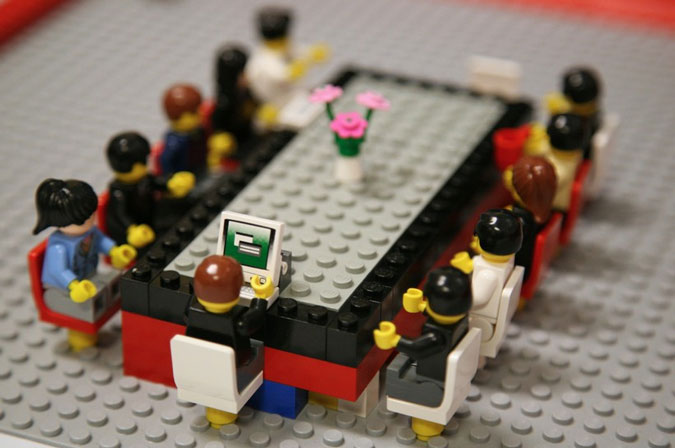Applying PRINCE2® to smaller projects can be difficult because it was originally designed to cope with the larger, more encompassing side of Project Management.
As such, when undertaking smaller projects, some Project Managers have a tendency to disregard PRINCE2 principles and take a more holistic approach. More often than not, this will be of detriment to the overall success of the project, as regardless of size it is still important to adhere to accepted processes within Project Management.
On our PRINCE2 training courses, our trainers go out of their way to make sure that everyone learns how to tailor PRINCE2 to their own project environment.

The 2009 'refresh' of PRINCE2 sought to give scope for the tailoring of PRINCE2 processes to projects of various sizes. As such, in this post we will discuss how to adapt key aspects of PRINCE2 to apply to small-scale projects and why this is so important. But first we'll discuss the way in which you shouldn't be managing small-projects.
Andy Trainer
13 Nov 2012
Ensuring quality is upheld with PRINCE2® is an ongoing process which means it requires continuous auditing. You can learn how to do this on our PRINCE2 Training Courses.
When managing a project with PRINCE2, it is necessary to prove to the customer that along the way, all the necessary quality management was undertaken. As such it is important to follow the Quality Trail.
In this post we'll outline each step of the Quality Trail, the resultant product and how to go about enacting it.

1/ Ascertaining Customer Expectations
Product = Project Mandate/Brief
Process = Starting up a Project (SU)
What needs to be done to make the end product adequate for customers and staff?
Andy Trainer
26 Nov 2012
APMG, the accrediting board for PRINCE2® have announced a format change to both the PRINCE2 Practitioner and Practitioner Re-Registration exams.
These changes have come about as result of a candidate survey which highlighted some issues with the timings of each exam. If you would like to learn all you need to pass your PRINCE2 exams, try our PRINCE2 Training Courses.
The fully changed formats for each are as follows:
Practitioner Exam
- 8 questions
- 10 question items per question, each worth one mark, total 80 marks
- 2.5 hours (150 minutes) duration, no additional reading time
- 44+ marks to pass (55%)
- Open book exam (official PRINCE2 manual only)
- Trainer pass mark - 53 out of 80 (66%)
Practitioner Re-Registration Exam
- 3 questions
- 10 question items per question, each worth one mark, total 30 marks
- 1 hour (60 minute) duration, no additional reading time
- 17+ marks to pass (55%)
- Open book exam (official PRINCE2 manual only)
- Trainer pass mark - 20 out of 30 (66%)
These changes will take immediate effect from January 1st 2013 and will entirely replace the 'old' format of the exams.
Andy Trainer
5 Dec 2012
APMG, the accrediting board for PRINCE2® have announced a format change to both the PRINCE2 Practitioner and Practitioner Re-Registration exams.
These changes have come about as result of a candidate survey which highlighted some issues with the timings of each exam. If you would like to learn all you need to pass your PRINCE2 exams, try our PRINCE2 Training Courses.
The fully changed formats for each are as follows:
Practitioner Exam
- 8 questions
- 10 question items per question, each worth one mark, total 80 marks
- 2.5 hours (150 minutes) duration, no additional reading time
- 44+ marks to pass (55%)
- Open book exam (official PRINCE2 manual only)
- Trainer pass mark - 53 out of 80 (66%)
Practitioner Re-Registration Exam
- 3 questions
- 10 question items per question, each worth one mark, total 30 marks
- 1 hour (60 minute) duration, no additional reading time
- 17+ marks to pass (55%)
- Open book exam (official PRINCE2 manual only)
- Trainer pass mark - 20 out of 30 (66%)
These changes will take immediate effect from January 1st 2013 and will entirely replace the 'old' format of the exams.
Andy Trainer
5 Dec 2012
The Plans theme is fundamental to the PRINCE2® methodology - the other themes (business case, organisation, quality, risk, change and progress) all depend on effective planning before, during and even after each project. A good plan will facilitate communication and control throughout the whole project life cycle.
Effective and structured planning also ensures that everyone involved in the project has the same information to work from and refer to. Crucially, in PRINCE2, all plans are created on a product-based technique – the final objective is identified first and then the plan is made of how to deliver this product.
Our PRINCE2 courses cover all of the PRINCE2 themes in detail, with a focus on real-life application of this knowledge.
The Planning Horizon
PRINCE2 can be applied to all scales of project, but detailed planning can be difficult for lengthier projects. If this is the case, the project will be broken down into smaller stages, and each of these will have separate plans. The planning horizon is the agreed length of time for which it is appropriate – or possible – to plan in detail.
Contents of PRINCE2 Plans
The different types of plans in a PRINCE2 project will follow a similar structure, in order to be easily accessible to everyone involved in the project. The level of detail that goes into each level of plan is determined by the scale of the project.
Andy Trainer
20 Jun 2012
The Plans theme is fundamental to the PRINCE2® methodology - the other themes (business case, organisation, quality, risk, change and progress) all depend on effective planning before, during and even after each project. A good plan will facilitate communication and control throughout the whole project life cycle.
Effective and structured planning also ensures that everyone involved in the project has the same information to work from and refer to. Crucially, in PRINCE2, all plans are created on a product-based technique – the final objective is identified first and then the plan is made of how to deliver this product.
Our PRINCE2 courses cover all of the PRINCE2 themes in detail, with a focus on real-life application of this knowledge.
The Planning Horizon
PRINCE2 can be applied to all scales of project, but detailed planning can be difficult for lengthier projects. If this is the case, the project will be broken down into smaller stages, and each of these will have separate plans. The planning horizon is the agreed length of time for which it is appropriate – or possible – to plan in detail.
Contents of PRINCE2 Plans
The different types of plans in a PRINCE2 project will follow a similar structure, in order to be easily accessible to everyone involved in the project. The level of detail that goes into each level of plan is determined by the scale of the project.
Andy Trainer
20 Jun 2012
There is a simple but effective technique for determining the root cause without resorting to the more complex tools and techniques included in the Analyse section of the Six Sigma DMAIC methodology - covered in depth on our Root Cause Analysis course as well as our Lean Six Sigma Green Belt, Black Belt & Yellow Belt courses:
The 5 Whys

A question every parent and teacher will be very familiar with, asking why is a great way of winding people up. Every time you ask why, someone has to explain the last reason they gave - narrowing down or opening up the original statement until the asker is happy - which can go on for a long time with children.
What makes asking why a workable solution for determining the root cause of a problem?
- It is an easy tool that requires little statistical analysis
- You document each step of the analysis so you always know the path to the root cause
- The root cause is found more often that not
- Multiple root causes are often stumbled upon during the process
Why 5?
5 has been identified as the optimum number of ways needed to find the root cause of a problem. Most root causes are identified around the 5th question but some more complex problems lead to more questions being asked.
Andy Trainer
25 May 2012
There is a simple but effective technique for determining the root cause without resorting to the more complex tools and techniques included in the Analyse section of the Six Sigma DMAIC methodology - covered in depth on our Root Cause Analysis course as well as our Lean Six Sigma Green Belt, Black Belt & Yellow Belt courses:
The 5 Whys

A question every parent and teacher will be very familiar with, asking why is a great way of winding people up. Every time you ask why, someone has to explain the last reason they gave - narrowing down or opening up the original statement until the asker is happy - which can go on for a long time with children.
What makes asking why a workable solution for determining the root cause of a problem?
- It is an easy tool that requires little statistical analysis
- You document each step of the analysis so you always know the path to the root cause
- The root cause is found more often that not
- Multiple root causes are often stumbled upon during the process
Why 5?
5 has been identified as the optimum number of ways needed to find the root cause of a problem. Most root causes are identified around the 5th question but some more complex problems lead to more questions being asked.
Andy Trainer
25 May 2012